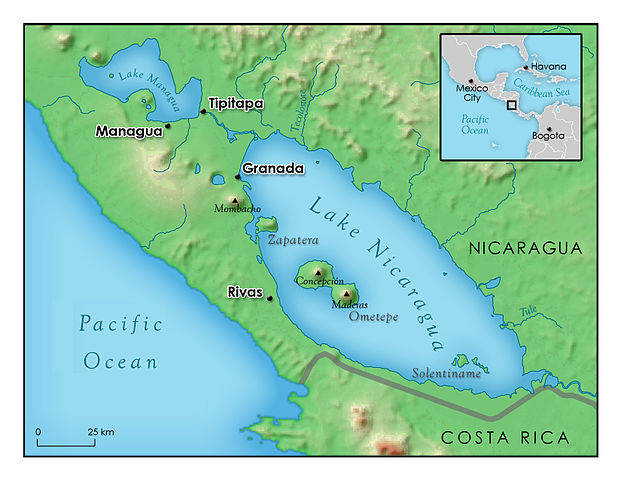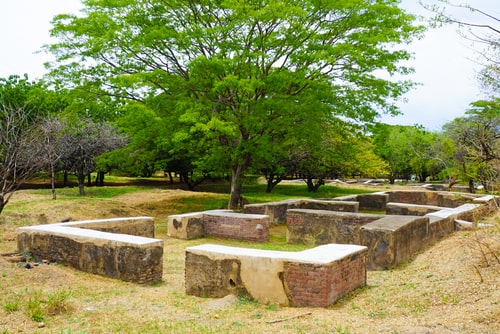Last updated on October 29th, 2022
Nicaragua, officially the Republic of Nicaragua, is the largest country in the Central American isthmus. It has a total area of 130,370 square km. Managua is its capital and largest city. Spanish is its official language while English, Miskito, Rama, and Sumo are some of its regional languages. Its official currency is Cordoba (NIO). Honduras and Costa Rica are its two land bordering countries. Colombia and El Salvador share maritime borders with Nicaragua. With these interesting facts about Nicaragua; let’s learn more about its culture, history, people, economy, geography, cuisines, the capital city, map, poverty and more.
Facts about Nicaragua’s geography and climate
1. Nicaragua consists of three definite geographical regions: the Atlantic Lowlands, the North-Central Highlands and the Pacific Lowlands, and the latter is the most populous region of the country.
2. Central America’s largest lake is Lake Nicaragua, which provides the water supply for much of Nicaragua and is the country’s largest tourist attraction. This lake is enormous and contains the largest lake island in the world.

3. Nicaragua’s famous Dual Volcano is the only one in the world that is fed by two separate flows of magma. This makes it possible for it to erupt from two types of magma channels.
4. There are around 430 volcanic islands in vast Lake Nicaragua. Nicaragua uses the intense steam from deep inside its volcanoes for geothermal energy.
5. The country is susceptible to both earthquakes and volcanic activity as well as being extremely susceptible to hurricanes.
6. Nicaragua has declared 70 areas as protected regions of water and land in order to protect their endangered species. These include different species of monkeys, boa constrictors, jaguars, sloths, green turtles and sea turtles.
7. Nicaragua’s wettest months are usually from June to October and its driest season from December through May. The most popular time to come visit is usually November.
8. The eastern, or “Mosquito coast” of Nicaragua receives the most rainfall in the country.
9. Almost all the tiny islands in the Atlantic off the coast of Granada, Nicaragua are for sale. Most prices range in the millions of dollars.
10. The higher elevations of the country have somewhat cooler weather than the tropical climates.
Facts about Nicaragua’s history
11. The earliest people are assumed to have been related to Mexico’s Aztec and Mayan people of Mexico. The Nicarao was one of the largest groups of early natives.
12. When the colonial Spanish came to the country under de Cordoba in the 1500s, they named it after these Nicarao Indians plus all the vast amounts of water the country had (agua is the Spanish word for water).

13. The Ruins of Leon Viejo in Nicaragua is the oldest city in all of Central America. It is over 1500 years old and is still occupied today. It was founded by the early Spanish settlers.
14. Britain came to the Caribbean coast from Jamaica and some other islands in the early 1800s and settled on the eastern coast but gradually ceded control back to Nicaragua during the following decades.
15. After the successful Mexican Revolution from Spain on September 15, 1821, Nicaragua then won its independence from Spain as well. September 15 is their national Independence Day holiday in Nicaragua.
16. Did you know Nicaragua had an American president? In 1856 William Walker from Tennessee seized control and declared himself to be Nicaragua’s President. He wanted to turn it into a slave state for the United States. The following year the Nicaraguan people kicked him out, aided by Cornelius Vanderbilt.
17. When the U. S. Marines occupied the country in the 1920s and 30s, August Cesar Sandino led their Nicaraguan resistance. Today he is one of their national heroes and the Sandinista political party is named for him.
18. Violent opposition to government corruption lead to civil war in the late 1970s and the Sandinista guerrillas rose to power. Their support of rebels in El Salvador lead the U. S. to sponsor contra guerrillas against the Sandinista through much of the 1980s.
19. Nicaragua elected–Violeta Chamorro–the first democratic woman president of any democracy in the world in 1990. She was the first female president of any Central American country and served until 1997.
20. Former Sandinista President Daniel Ortega lost three consecutive elections before finally being elected President in 2006 and reelected four years later. He is Nicaragua’s current President.
Related: 45 Interesting facts about Uruguay
Nicaragua on the map
Nicaragua’s economy
21. Almost three quarters of the Nicaraguan people live on only $2 per day and nearly half live in poverty.
22. You will pay an entry tax of $10 payable in US dollars or Córdobas (cash only). Be prepared to pay a 15 percent sales tax on all your purchases when you shop.
23. The country has the lowest crime rate of any Central American country and is considered to be its safest country in which to travel.
24. The Nicaraguan economy is based mostly on agriculture, tourism, mining, and manufacturing.
25. You can get 27 Nicaraguan Cordobas, their national currency, for one American dollar.
. . . continue reading on the next page.
